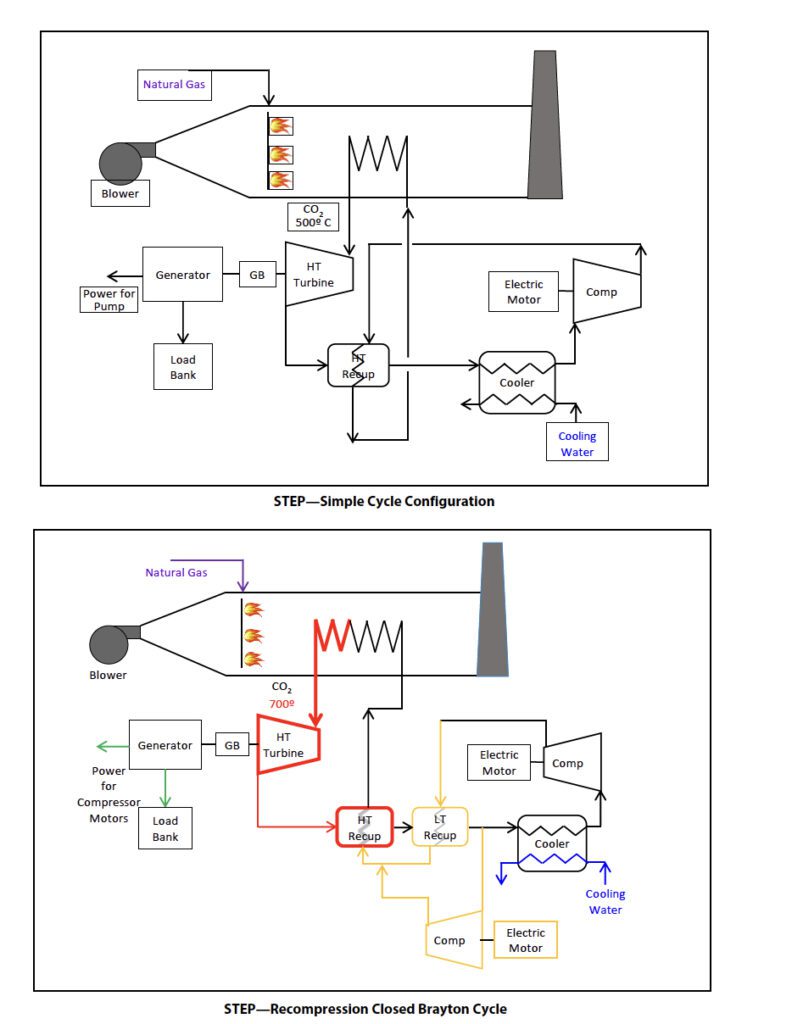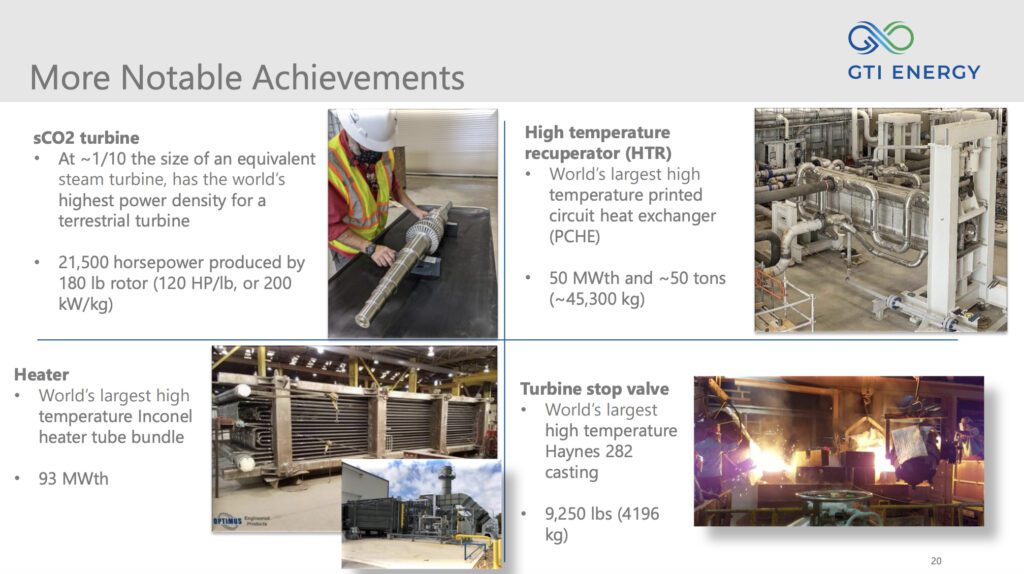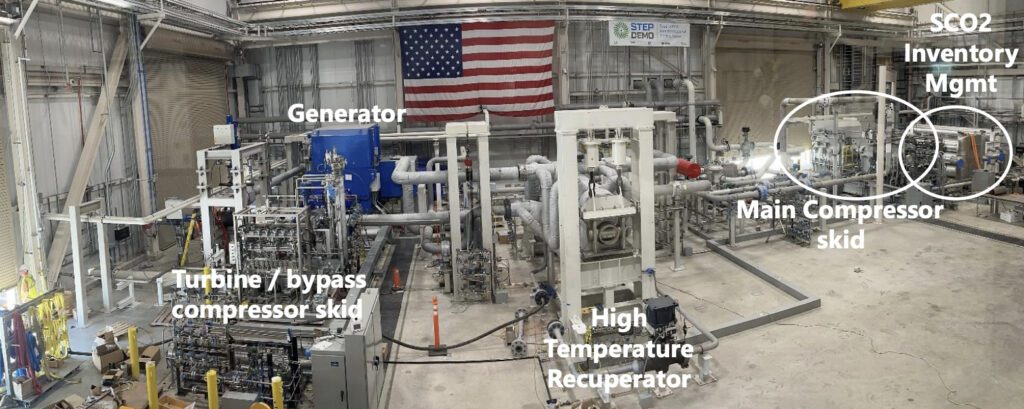Breakthrough for sCO2 Power Cycle as STEP Demo Completes Phase 1 of 10-MW Project
In a significant breakthrough for the development of supercritical carbon dioxide (sCO2) power cycles, the 10-MWe Supercritical Transformational Electric Power (STEP) Demo pilot plant in San Antonio, Texas, has wrapped up Phase 1 testing, demonstrating the commercial readiness of its next-generation indirect sCO2 Brayton cycle.
The $169 million project—the largest of its kind in the world—demonstrated a simple cycle configuration of the novel power cycle at a 10-MW scale at the fully integrated power plant built at the Southwest Research Institute (SwRI) in Texas. The initial system configuration comprises a single compressor, turbine, recuperator, and cooler, with heat supplied by a natural gas–fired heater (that closely resembles a duct-fired heat recovery steam generator).
During Phase 1 testing, the project achieved full operational speed of its turbine at 27,000 RPM, operating at 500C and 250 bar. It generated 4 MWe of grid-synchronized power. “The data collected from the pilot plant will optimize the design, performance, and operability of future sCO2 power systems, laying the foundation for widespread commercial deployment,” said technology development firm GTI Energy, which is spearheading the project.
“The 10-MW scale and 500C temperature are well suited for waste heat applications, providing emission-free power from otherwise wasted heat,” explained William Follett, GTI Energy program director of sCO2 Technologies. “The next phase of the project, expected to start in 2025, will reconfigure the plant to a Recompression Brayton Cycle (RCBC) configuration and increase the turbine inlet temperature to 715C to provide a significant boost in efficiency. RCBC will be applicable to power generation for a number of zero/low emission heat sources, such as solar thermal, nuclear (fission and fusion), and biomass and fossil fuel with carbon capture,” he said.
When the second—and final—phase is completed, the STEP Demo is expected to generate 10 MWe hourly. But its bigger contributions will be to boost technology advancement for the promising power cycle. “The success of this project underscores the potential of sCO2 technology to transform the future of power generation, bringing us one step closer to commercializing innovations that will drive more sustainable and resilient energy systems,” noted Don Stevenson, vice president of carbon management and conversion at GTI Energy on Monday.
sCO2: A Power Cycle With Big Potential
As POWER has reported, sCO2 power cycles are essentially Brayton cycles that utilize supercritical CO2 working fluid to convert heat to power, offering the potential for higher system efficiencies than other energy conversion technologies (such as steam Rankine or Organic Rankine cycles), especially when operating at elevated temperatures.
For more on sCO2 power cycles, see POWER‘s explainer: What Are Supercritical CO2 Power Cycles? |
The Brayton cycle circulates heated working fluid and compresses it, which spins a generator that creates electricity. The unique properties of supercritical sCO2 offer significant advantages over steam as a working fluid in closed and semi-closed cycles. In its supercritical state—achieved at temperatures above 31C (88F) and pressures above 7.4 MPa (1,070 psia)—sCO2 acts as a dense, compressible fluid, GTI has noted. This allows it to efficiently absorb thermal energy, be compressed, and drive turbines, resulting in turbomachinery that is up to 10 times smaller than comparable steam or air systems for the same power output. Along with higher efficiencies, the cycle could reduce water usage and heat source flexibility, it says.
STEP has set out to demonstrate an indirect sCO2 recompression closed Brayton cycle in two distinct phases. In Phase 1, testing was based on a simple cycle configuration comprising a single compressor, turbine, recuperator, and cooler.
RCBC, in which STEP will be reconfigured as part of Phase 2, involves a high-efficiency cycle capable of achieving the program’s thermodynamic efficiency goals of more than 50%. In Phase 2, the second (lower-temperature) recuperator and a bypass compressor will be installed. While Phase 1 sought to demonstrate the system’s controls and operability and validate the performance of key components, Phase 2 will address technical risks while minimizing the added complexity at each phase.

Culminating a Decade Rigorous R&D
Completion of Phase 1 culminates a major effort by the STEP Demo team, which began in 2013 to establish a working sCO2 power cycle with backing from the U.S. Department of Energy’s (DOE’s) Office of Fossil Energy and Carbon Management. SwRI, GTI Energy, and GE broke ground on the STEP Demo site in 2018. The facility notably achieved mechanical completion in October 2023, which paved the way for full system commissioning tests to kick off in December 2023. Performance testing began in March 2024.
“This has been an 8-year-long project (so far) with numerous challenges to achieving this breakthrough technology,” Follett noted on Monday.
Among significant hurdles was the development of several world-first components, including the largest printed circuit heat exchanger, the largest turbine stop valve and control valve, and the largest installation of Inconel 725 piping ever built. These innovations required major advances in materials science and manufacturing. For example, engineers had to learn how to cast large-scale components using high-temperature alloys like Haynes 282 for the turbine stop valve and 740H for heater tubes and piping.
Specialized techniques for inspecting and repairing turbine blades were also developed to handle the extreme operational conditions. Finally, the team had to develop extensive commissioning procedures that would be approved by regulators to ensure safe operation of the novel system.

Development of the turbine, designed to advance from Technology Readiness Level (TRL) 6 (an engineering prototype) to TRL 7 (a full-scale prototype) has marked a particularly notable technology triumph. The three-stage turbine encased in a fabricated barrel-style casing has a gross power output of 16 MW and a power density of 200 kW/kg (120 hp/lb)—boasting the highest terrestrial power density ever achieved in the world. Achieving this level of power density required a single-piece rotor and blades, which resulted in long lead times, and careful thermal management, Follett told POWER last year.
The successful commissioning of the compressor loop marked another critical milestone. The compressor, which was tested at both simple cycle and RCBC speeds, includes a cooling tower, an sCO2 inventory management system, and a main process cooler. Commissioning the compressor, notably, identified several gaps in knowledge and performance for commercial sCO2 compressors. The compressor’s map performance differed significantly from predictions, reducing its turndown capability, and liquid operation emerged as an essential requirement to support cold starts, Follett noted last year. Additionally, accurately calculating compressor efficiency proved difficult due to the low-temperature differentials across the compressor. That required the installation of torque and density meters to improve measurement accuracy.
sCO2 Cycles Finding Traction in Evolving Power Space
Along with GTI and SwRI, the pilot project’s partners include GE Vernova’s Advanced Research and the DOE’s National Energy Technology Laboratory (NETL). The project also includes contributions from 10 U.S. and international partners: American Electric Power, Southern Co., Services, Australia’s Commonwealth Scientific and Industrial Research Organization, Thailand’s EGAT, France’s Engie, the Korean Electric Power Company, Natural Resources Canada, Brazil’s Petrobras, Indian firm Spectrum Impact, and the Texas Commission on Environmental Quality (TCEQ).
“Commercial partners provide guidance to the operation, have access to project data, and have preferential rights to project [intellectual property],” STEP has noted. However, additional partners are welcome, it says.
For now, the STEP demo, which has $125 million in funding from the DOE, is set to remain an ongoing testbed for future sCO2 cycle-based power development, the team said. “The plant design is flexible and can be reconfigured to accommodate future testing to continue technology optimization and component development,” it said.
The joint-industry partnership is proving pivotal as interest in sCO₂ power cycles ramps up, driven by the need for technologies that enhance power generation efficiencies, improve thermal efficiency and operational flexibility, and reduce costs and environmental impact across various applications. Experts have told POWER the attraction to sCO₂ technology stems in large part from their adaptability to multiple heat sources, including solar thermal, nuclear, and waste heat recovery. Their ability to operate with smaller, more compact turbomachinery, significantly reducing plant footprint and capital costs, adds to their commercial appeal, particularly for industrial applications and gas turbine retrofits.
However, the technology still faces challenges, including the substantial costs associated with high-pressure components and materials, particularly in larger-scale applications where operating at pressures exceeding 300 bar is required. Additionally, the integration of sCO₂ cycles in certain systems, such as carbon capture, has limitations when compared to traditional steam cycles.
At least one company, NET Power, has set out to build a utility-scale 300-MW gas-fired power plant based on the Allam-Fetvedt sCO2 power cycle at an Occidental-hosted site near Odessa, Texas. While originally anticipated to begin operations in 2026, NET Power CEO Danny Rice said during an earnings call in August that the plant is now on schedule for startup “between the back half of 2027 and the first half of 2028.” NET Power has partnered with Baker Hughes to commence the first phase of a rigorous turboexpander equipment validation program at its La Porte demonstration facility in Texas.
Other pilot programs are also advancing sCO2 technology, including the CARBOSOLA project in Germany and several U.S. DOE-funded projects exploring sCO2 use in concentrated solar power (CSP) and waste heat recovery. Sandia National Laboratories, for example, continues to refine components and system performance for broader applications in both CSP and nuclear energy. Companies like Echogen Power Systems are developing sCO2-based systems for industrial applications.
“Achievement of the simple cycle max milestone [at the STEP Demo] is highly encouraging both for the project and commercialization of sCO2 power cycle technology,” noted John Crane, manager of NETL’s Advanced Turbines Technology on Monday. “This is the largest scale demonstration of the technology to date and, because the plant utilizes turbomachinery and process equipment that are representative of commercial implementation, it also demonstrates a scalable technology pathway to larger applications in the 10s-100s MW range.”
—Sonal Patel is a POWER senior editor (@sonalcpatel, @POWERmagazine).
